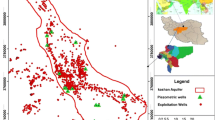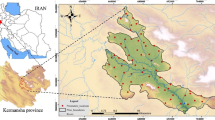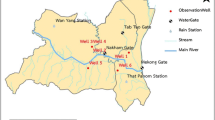Abstract
Groundwater fluctuations forecasting is a valuable tool for the intelligent management of groundwater resources that prevents additional costs to the system. In this research, time series analysis methods, including Auto-Regressive Integrated Moving Average (ARIMA) and Holt-Winters Exponential Smoothing (HWES), were used for developing a short-term model and the forecasting of the groundwater fluctuations in six piezometer wells around the Gohar Zamin Iron Ore Mine. To take advantage of all the features of the robustly developed ARIMA and HWES models, the innovative combination of these methods with specific weights was used to predict groundwater levels. The results of Diebold and Mariano’s test were applied for the innovative combination of the developed models in six piezometers, and well no. 2 with a p-value higher than 5% was selected due to stable environmental conditions and was analyzed and interpreted. For this purpose, 250 non-seasonal data of daily groundwater level were used, of which 200 data are for modeling, and 50 data are for water level forecasting. The research results show that among all the forecasting, the least-squares method in the innovation of combining models has the highest accuracy for forecasting the groundwater fluctuations in the short term. All the forecasts in this period time show a decrease in the groundwater level, indicating the effects of pumping wells in the Gohar Zamin Iron Ore Mine area.





Similar content being viewed by others
REFERENCES
Akaike, H., Factor analysis and AIC, Selected papers of Hirotugu Akaike, Springer, 1987, pp. 371–386.
Box, G.E.P., Jenkins, G.M., and Day, H., Time Series Analysis: Forecasting and Control. Holden-Day, 1976. https://books.google.com/books?id=1WVHAAAAMAAJ
Chong, Y.Y. and Hendry, D.F., Econometric Evaluation of Linear Macro-Economic Models, The Rev. Econ. Studies, 1986, vol. 53, no. 4, pp. 671–690. https://doi.org/10.2307/2297611
Clemen, R.T., Combining forecasts: A review and annotated bibliography, Int. J. Forecast., 1989, vol. 5, no. 4, pp. 559–583. https://doi.org/10.1016/0169-2070 (89)90012-5
Cleveland, W.S., Robust locally weighted regression and smoothing scatterplots, J. Am. Stat. Assoc., 1979, vol. 74, no. 368, pp. 829–836.
Curtis, Z.K., Li, S.-G., Liao, H.-S., and Lusch, D., Data-driven approach for analyzing hydrogeology and groundwater quality across multiple scales, Groundwater, 2018, vol. 56, no. 3, pp. 377–398. https://doi.org/10.1111/gwat.12584
Diebold, F.X. and Mariano, R.S., Comparing predictive accuracy, J. Business Econ. Stat., 2002, vol. 20, no. 1, pp. 134–144.
Dobrovol’skii, S.G., Year-to-year and many-year river runoff variations in Baikal drainage basin, Water Resour., 2017, vol. 44, no. 3, pp. 347–358. https://doi.org/10.1134/S0097807817030083
Elganainy, M.A. and Eldwer, A.E., Stochastic forecasting models of the monthly streamflow for the Blue Nile at Eldiem Station, Water Resour., 2018, vol. 45, no. 3, pp. 326–337. https://doi.org/10.1134/S0097807818030041
Elganiny, M.A. and Eldwer, A.E., Enhancing the forecasting of monthly streamflow in the main key stations of the River Nile Basin, Water Resour., 2018, vol. 45, no. 5, pp. 660–671. https://doi.org/10.1134/S0097807818050135
Gideon, S., Estimating the dimension of a model, The Annals of Statistics, 1978, vol. 6, no. 2, pp. 461–464. https://doi.org/10.1214/aos/1176344136
Guanhua, Z., Ding, W., Liu, H., Yi, L., Lei, X., and Zhang, O., Quantifying climatic and anthropogenic influences on water discharge and sediment load in Xiangxi River basin of the Three Gorges Reservoir area, Water Resour., 2021, vol. 48, no. 2, pp. 204–218. https://doi.org/10.1134/S0097807821020184
Guo, T., Song, S., Shi, J., and Li, J., Groundwater depth forecasting using configurational entropy spectral analyses with the optimal input, Groundwater, 2020, vol. 58, no. 5, pp. 749–758. https://doi.org/10.1111/gwat.12968
Hannan, E.J. and Quinn, B.G., The determination of the order of an autoregression, J. Royal Stat. Soc.: Series B (Methodol.), 1979, vol. 41, no. 2, pp, 190–195. https://doi.org/10.1111/j.2517-6161. 1979.tb01072.x
Holt, C.C., Forecasting seasonals and trends by exponentially weighted moving averages, Int. J. Forecasting, 2004, vol. 20, no. 1, pp. 5–10. https://doi.org/10.1016/j.ijforecast.2003.09.015
Makridakis, S. and Hibon, M., The M3-Competition: results, conclusions and implications, Int. J. Forecasting, 2000, vol. 16, no. 4, pp. 451–476. https://doi.org/10.1016/S0169-2070(00)00057-1
Nogueira, G.E.H., Schmidt, C., Trauth, N., and Fleckenstein, J.H., Seasonal and short-term controls of riparian oxygen dynamics and the implications for redox processes, Hydrol. Processes, 2021, vol. 35, no. 2, e14055. https://doi.org/10.1002/hyp.14055
Pan, J., Shangguan, W., Li, L., Yuan, H., Zhang, S., Lu, X., Wei, N., and Dai, Y., Using data-driven methods to explore the predictability of surface soil moisture with FLUXNET site data, Hydrol. Processes, 2019, vol. 33, no. 23, 2978–2996. https://doi.org/10.1002/hyp.13540
Stock, J.H. and Watson, M.W., Forecasting using principal components from a large number of predictors, J. Am. Stat. Assoc, 2002, vol. 97, no. 460, pp. 1167–1179. http://www.jstor.org/stable/3085839
Timmermann, A., Chapter 4 Forecast Combinations, in Handbook of Economic Forecasting, Elliott, G., Granger, C.W.J., and Timmermann, Eds., Elsevier, 2006, vol. 1, pp. 135–196. https://doi.org/10.1016/S1574-0706(05)01004-9
Yu, X., Zhang, X., and Qin, H., A data-driven model based on Fourier transform and support vector regression for monthly reservoir inflow forecasting, J. Hydro-Environ. Res., 2018, vol. 18, pp. 12–24. https://doi.org/10.1016/j.jher.2017.10.005
Author information
Authors and Affiliations
Corresponding author
Ethics declarations
The authors declare that they have no conflicts of interest.
Rights and permissions
About this article
Cite this article
Najafabadipour, A., Kamali, G. & Nezamabadi-pour, H. The Innovative Combination of Time Series Analysis Methods for the Forecasting of Groundwater Fluctuations. Water Resour 49, 283–291 (2022). https://doi.org/10.1134/S0097807822020026
Received:
Revised:
Accepted:
Published:
Issue Date:
DOI: https://doi.org/10.1134/S0097807822020026




